Tell Me About It: Focused Language Stimulation In AAC Vocabulary Teaching
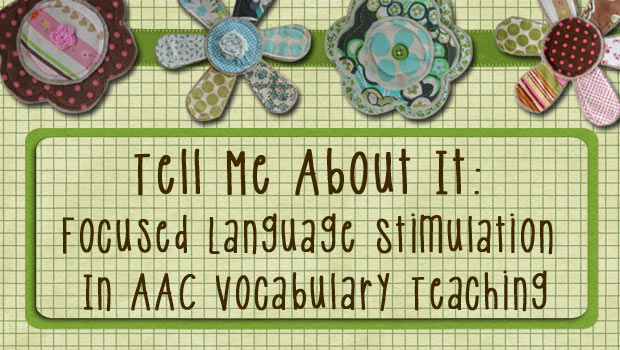
Earlier this month, we introduced a general sequence of how we conceptualize semantic instruction. We promised to elaborate on that.
There are two things that I really love about this approach to to vocabulary teaching. The first is that is honors a principle that we know to be true: providing repetition with variety not only helps us reach learners with different strengths, but also gives our AAC learners much-needed practice. The other thing that makes this really work for us is that assessment has an active role but not a central one. Testing takes a backseat to teaching. As we all know, getting accurate assessment information from people who are learning their AAC systems is a huge challenge. Often, our AAC friends don’t have decent test-taking skills so we’re not really testing what we think we’re testing.
Just last week I got to see Kristofer, an adorable little fellow who is in this situation. Kristofer is at the early stages of AAC learning. His school team is under immense pressure to measure how much curricular content he learning in his inclusive classroom. Kristofer is trialing an eye gaze system and, although he is making reasonable progress, he doesn’t yet have the competency to use the eye gaze device to answer questions on a test or quiz. He’s still learning the system, so anything we do to use that system to test him tells us more about how much he has learned about the operational aspects of the system than it does about the curricular content we were trying to assess. The same can be said of his use of a no tech eye gaze board, a PODD book, and switch scanning. He is just learning to use those tools. Testing him with tools he doesn’t yet know how to use doesn’t make sense.
Imagine this: You are given a mainframe computer with a new operating system and software that is unfamiliar to you. You’ve been asked to use that to create a multimedia presentation explaining how to bake a cake. You’ve baked lots of cakes, but chances are, you will be minimally successful, at best. Why? Well, certainly not because you don’t know how to bake a cake. It’s the tool that is holding you back. Once you’ve gained competency with the mainframe and software, you’ll surely succeed at making a terrific presentation about cake-baking.
That’s a long way of saying that we love this approach because assessment (which is a minefield for AAC learners) is not the main focus. We love it because it focuses on teaching.
Here’s the general approach:
STEP 1: Introduce the new word(s) using focused AIDED language stimulation
STEP 2: Teach the new word(s) with explicit instruction activities
STEP 3: Elaborate on the new word meanings with engaging practice activities
STEP 4: Provide repeated exposure to the new word(s) on an ongoing basis
STEP 5: Check for understanding and reteach, as necessary.
In this post, we’ll elaborate on the first step, introduce new words using focused aided language stimulation. Focused language stimulation (Dickinson, Cote, & Smith, 1993) is a strategy used to highlight new words by using them over and over in discourse and instructional exchanges.
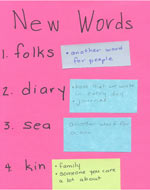
Early on in Step 1, we have to craft student-friendly definitions for the words we’re introducing. Personally, I find this part to be a bit challenging, and not something I do well on the fly. It’s harder than you think to define a new word without using other words that the learner doesn’t understand. For me, some advance preparation is needed to come up with a way to define the word in a short phrase or sentence that the learner will understand. This picture shows some of the definitions from a therapy session in Step 2, but I’m using it here to show examples of how I defined words from a book we were reading.
With our student-friendly definitions in hand (or, in my case, on sticky notes) we are set and ready to explain the new word meanings when they are first used. This works well within the ordinary narrative of your therapy/teaching (E.g., “I expect a lot of effort from you. Effort means ‘trying hard.’”). At this step, there is no specific activity to define the word; Instead, we just work the definition into the ongoing narrative of the conversation so that the new word is embedded into a rich context. Context aids learning and is critical in Step 1, especially for those at the beginning stages of language development.
It helps to give multiple examples to link the new/target words with words the AAC learner already knows (E.g., “Great job on your quiz! I bet you tried hard. I bet it took a lot of effort to learn that.” “Look at Coach Peyton sweat! She’s sure putting a lot of effort into those exercises. She’s working hard!”).
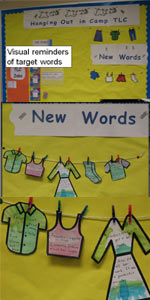
We continue to do this, looking for any and all opportunities to sprinkle our language with the new/target word. (If you use the Hodson/Cycles Approach in phonological therapy, you’ll see similarities to the auditory bombardment/focused auditory input.) In this context it means looking for opportunities throughout the day when you can pepper your language with the new/target word to reinforce it’s meaning in context. So, Step 1 is all about using auditory bombardment with the target word (E.g., Instead of “Put it at the bottom of the page” try “Put it at the base of the page. Where? The bottom. The base of the page”). It takes some effort and attention at first, but once you get in the habit of it, it becomes very natural.
There are two more considerations for Step 1 that we’d like to discuss here.
- Aided language input: Use this pivotal strategy as often as you can, especially when you are providing the student-friendly definition.
- Visual supports: Find a way to make the new words and graphic symbols, if applicable, visible. Most often, we talk about visual supports for the AAC learner to help with language comprehension, organization, transitions, etc. In this case, we’re suggesting visual supports that benefit us, the interventionists, as well. We’ve found that having the new words in a visible location helps us remember to use them more often. Depending on the setting, you may be able to use a bulletin board, poster, portable word wall, or even just a sheet of paper that is displayed on a stand. Do whatever makes sense to have the new words visible to you and the learner.
Step 1 is about exposing the AAC learner to new words and their meanings in rich contexts. Repeatedly. In natural conversation and instructional exchanges. In future posts, we elaborate on some of the other parts of this approach to vocabulary teaching. In the meantime, we’d love to hear any thoughts that you have on teaching new words.
Filed under: PrAACtical Thinking
Tagged With: aided, aided language input, intervention, language therapy, new words, semantics, vocabulary
This post was written by Carole Zangari

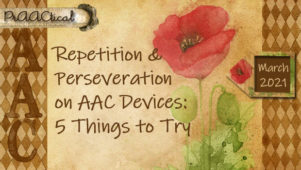
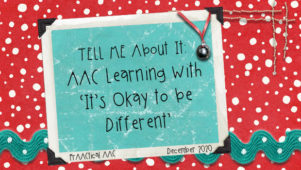
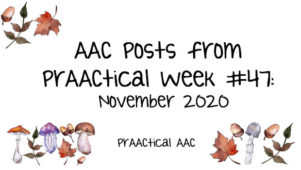
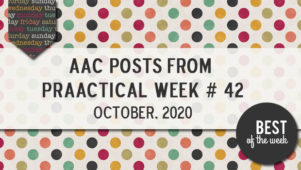
2 Comments
This post was very helpful. One of our non verbal students is reluctant to use his AAC device. We have a book for him to use as conversation starters for new friends, but classwork has taken a bit of a downward turn. The five steps for vocabulary acquisition were easy and something I can pass along to his teachers and paras.
I have heard there is a website for student friendly definitions. Does anyone know what it is?